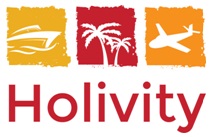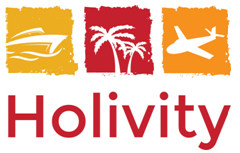Iceland Mixed Activity Holiday - Reykjavik to Vik
Introduction to the Land of Ice and Fire
Iceland is a magical, other-worldly island marooned near the top of the globe just below the Arctic Circle with palpable energy and incredible natural beauty. It's rugged, cratered, Martian-like landscape is constantly evolving and provides a glimpse into the earth's interior. It is a vast volcanic laboratory with rocky terrain, majestic mountains, gurgling geysers and wonderful waterfalls. The land is shaped by geothermal activity and the enormous forces of tectonic plates from the Rift Valley Ridge in Þingvellir national park to its sulphurous bubbling mud pools and black sand beaches which hug the coast.
Iceland is sparsely populated with annual visitors significantly outnumbering the national population of c350,000 each year. The first thing you notice about local Icelandic people is that they have adapted to work with and around the might of Mother Nature to make the land their own. Tourism is naturally one of the major industries alongside fishing, aluminium production and geothermal and hydro electricity. Icelanders have worked hard to recover from financial upheaval and you'll find the locals very friendly and talkative. In Iceland, the social scene revolves around geothermal spas and swimming pools; bathing is the equivalent of going to the pub in the UK.
In this blog we talk through the itinerary we followed during our week travelling the south-west of Iceland in March. This gives you an idea of how different activities can be combined into day trips and places you might want to stay.
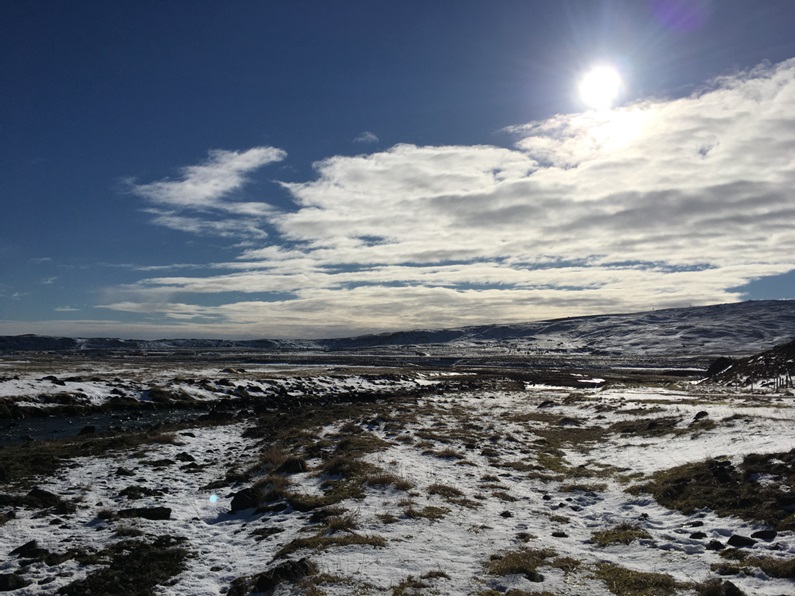
Iceland is well known for it's rugged, rocky, Martian-like terrain
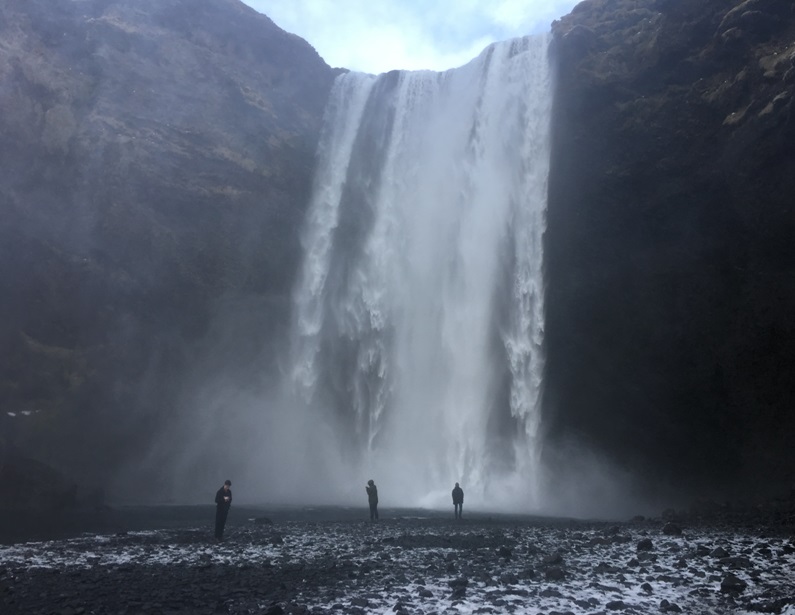
Wonderful waterfalls - pictured here is Skogafoss waterfall in the south west
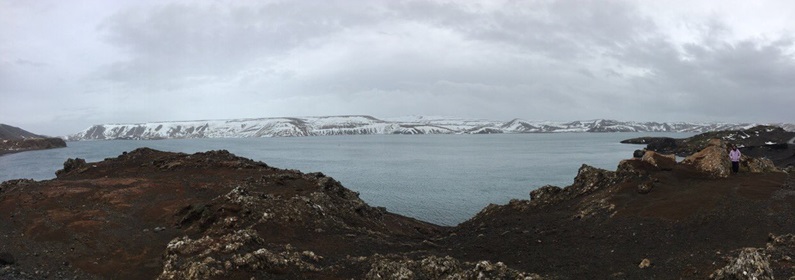
Kleifarvatn, the largest lake of the Reykjanes Peninsula
Day 1 (Saturday) - afternoon flight to Reykjavik, stock up on food, check into first hotel
When you make an international flight to Iceland, you'll actually land in Keflavik, which is 20 minutes south-west of Reykjavik, despite the airport being referred to as "Reykjavik". This is because Reykjavik is not only the name for Reykjavik town itself but also the wider surrounding area. This is not an issue if you're hiring a car but otherwise don't plan on being able to walk from the airport to your Reykjavik hotel. It's a bit confusing that there is also a domestic Reykjavik airport very close to the centre of Reykjavik but this is not where you will fly into. Upon arrival we recommend visiting one of the Bonus supermarkets in either Keflavik or Reykjavik but check the opening times as some shut at 7pm. We stayed in Hotel Lotus, set an 8 minute drive from central Reykjavik with free car parking. Hotel Lotus was easy to find, 100 metres off the main road and offered a pleasant, comfortable stay. Don't expect "pretty" hotels in Reykjavik as the whole town has a rather industrial feel to it.
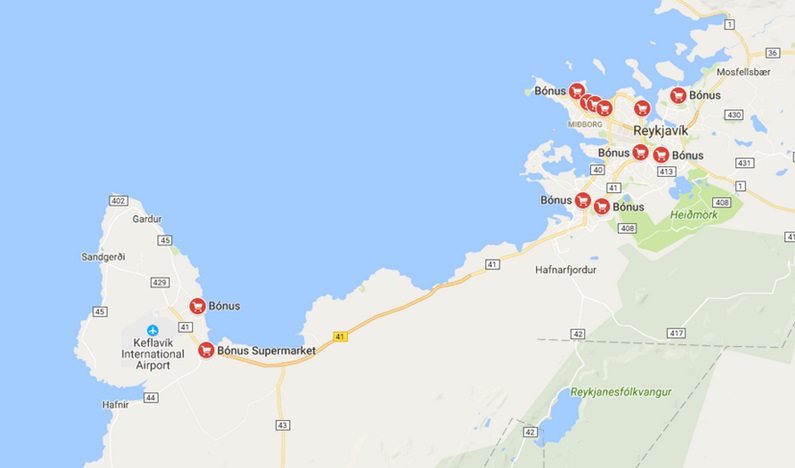
Stocking up on food from a Bonus supermarket in Reykjavik
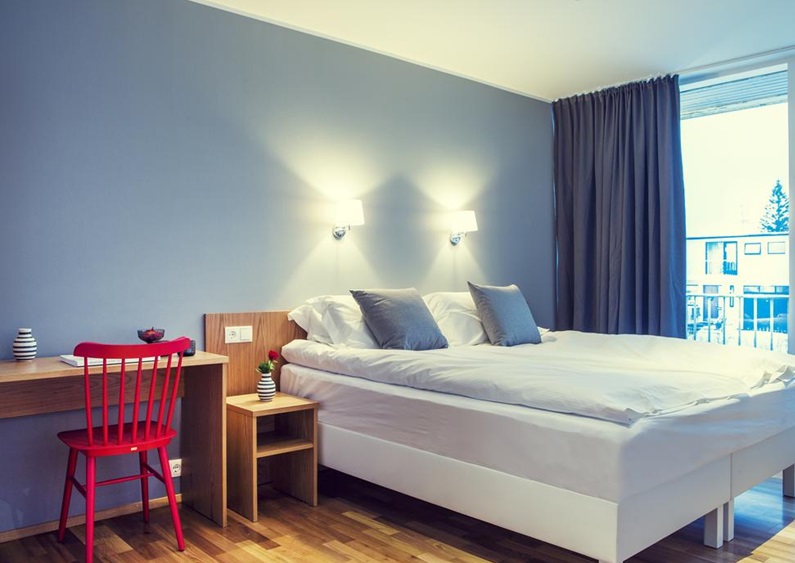
Hotel Lotus, set an 8 minute drive from central Reykjavik with free car parking
Day 2 (Sunday) - volcanic landscape horse riding, Reykjadalur geothermal hike and drive to Hvolsvöllur
We went straight into Icelandic activities on our first full day with a one hour morning volcanic landscape horse riding tour, starting at 9:30am. We went with a company called The Icelandic Horse located at Surtlugata just a 10-15 minutes drive outside of central Reykjavik. The Icelandic Horse is owned by Becca who was also our host for the morning and led the ride. Becca was very welcoming and engaging and gave a thorough, detailed introduction and constant instruction during the tour which helped put beginners at ease. Horses are an important part of Icelandic culture and tradition so if you have even a vague equestrian interest or just a sense of adventure and desire to try something new we definitely recommend it.
The tour takes one hour and meanders around the nearby lava fields, providing an initial sense of the local landscape. We got a unique insight into Icelandic horses and their different gaits, including the "Tolt" (pronounced a bit like "taught") which only Icelandic horses can manage. The tolt is a similar speed to a trot but involves one foot of the horse staying on the ground at all times, making for a much more gentler ride. If you go horse riding in Iceland in the winter you definitely need to be prepared for the cold. A common saying on the island is that there is no such thing as bad weather, only bad clothing. With this in mind, you'll get cold very quickly sitting static on a horse so wear 5-6 layers on top at least one thermal base layer on your legs. The Icelandic Horse also offer full length "body suits" to go over other clothing if you wish to use one.
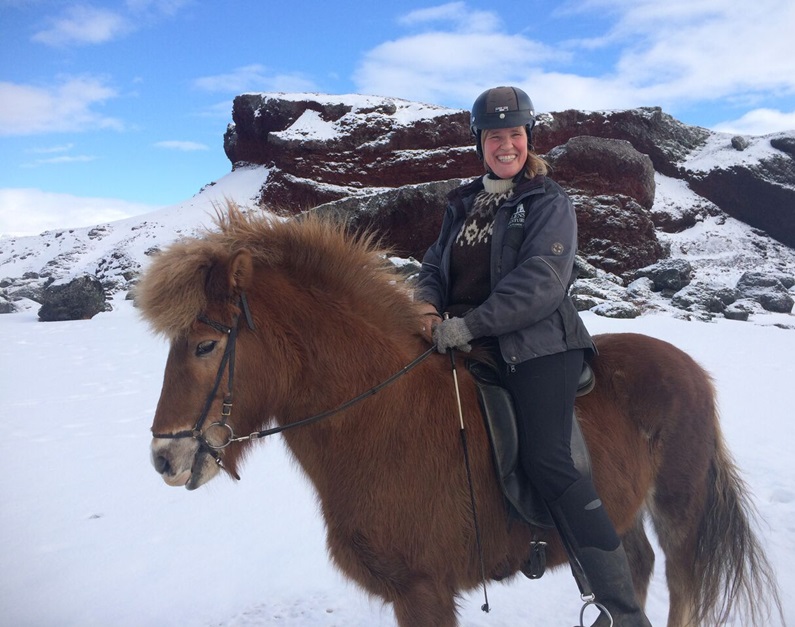
Becca, the owner and our tour host for The Icelandic Horse trek
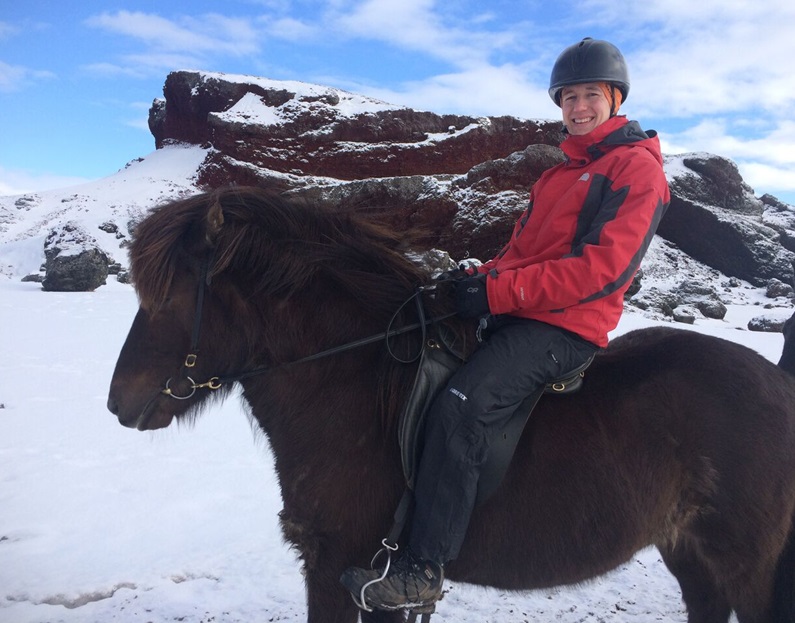
Getting ready to attempt the Tolt
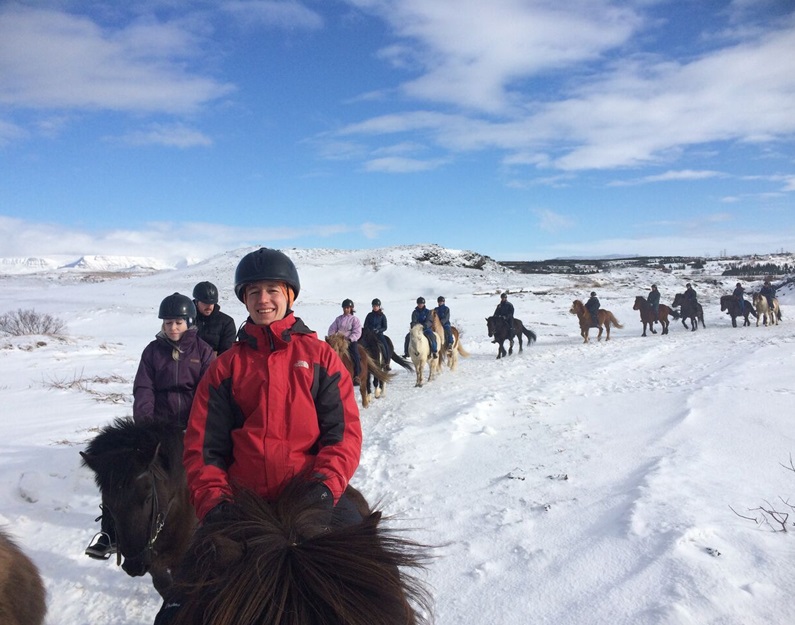
The 1 hour trek weaves around the beautiful Icelandic countryside
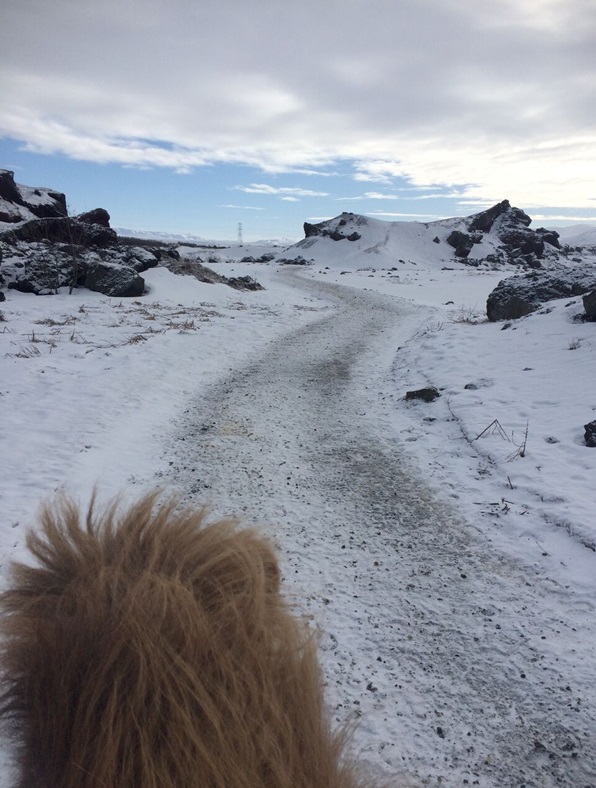
On the path back home, freezing but in ore of the beautiful landscape
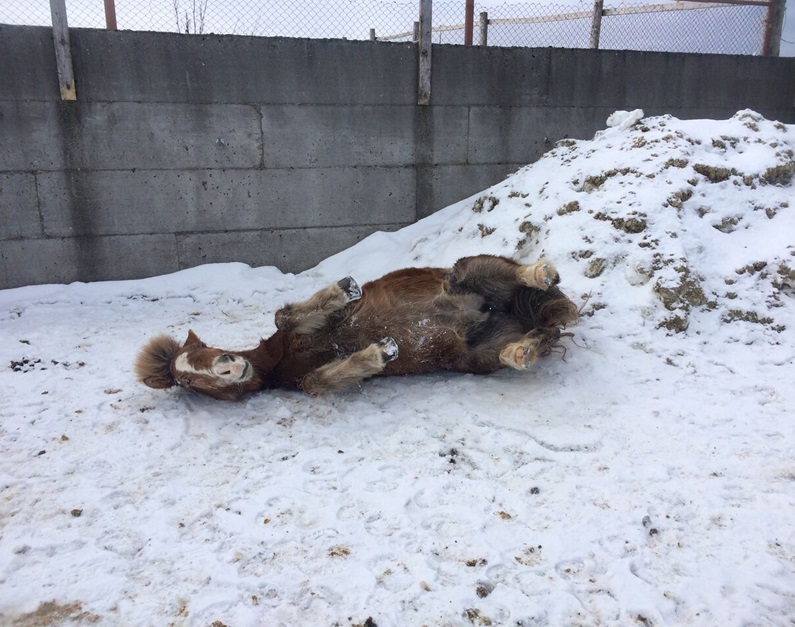
Who said Icelandic horses can't have fun too?
A good afternoon activity to combine with horse riding, especially if you are travelling east along the southern part of Iceland anyway, is the Reykjadalur hiking area and geothermal pools. Reykjadalur is a hiking trail just outside of Hveragerði, a short 40 minute drive from Reykjavik. Reykjadalur directly translates to “steam valley” and it holds true to its name with steam floating in the air everywhere on this hike. Some of the rocks along the hike look like something from Lord of the Rings and with the ever present wind on your face you could be forgiven for feeling like a Viking as you trek up the slope. The trek is only around 3km but packs a lot of beauty with geothermal activity, bubbling mud pools, otherworldly rock formations and stunning views of the surrounding snow-topped mountains.

Reykjadalur is a hiking trail just outside of Hveragerði, a short 40 minute drive from Reykjavik
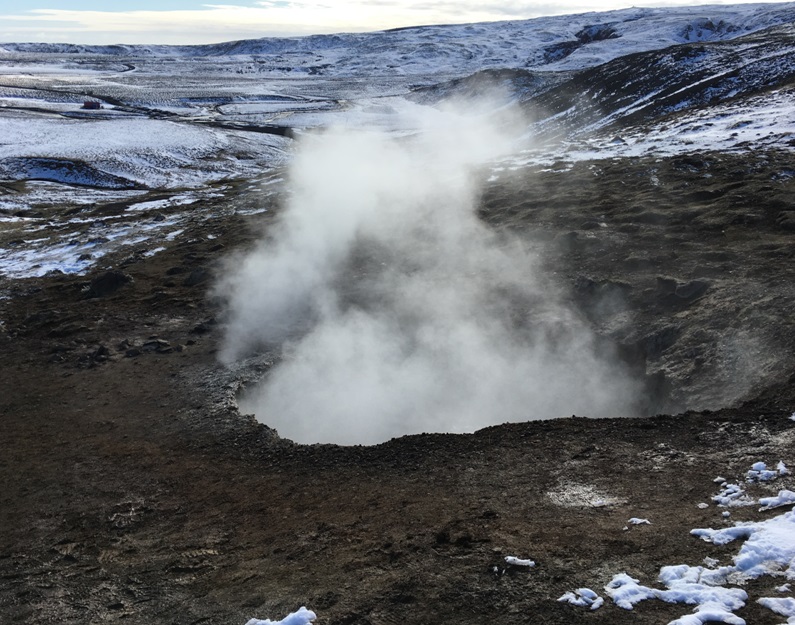
Gurgling hot pool just off the path on the Reykjadalur hiking trail
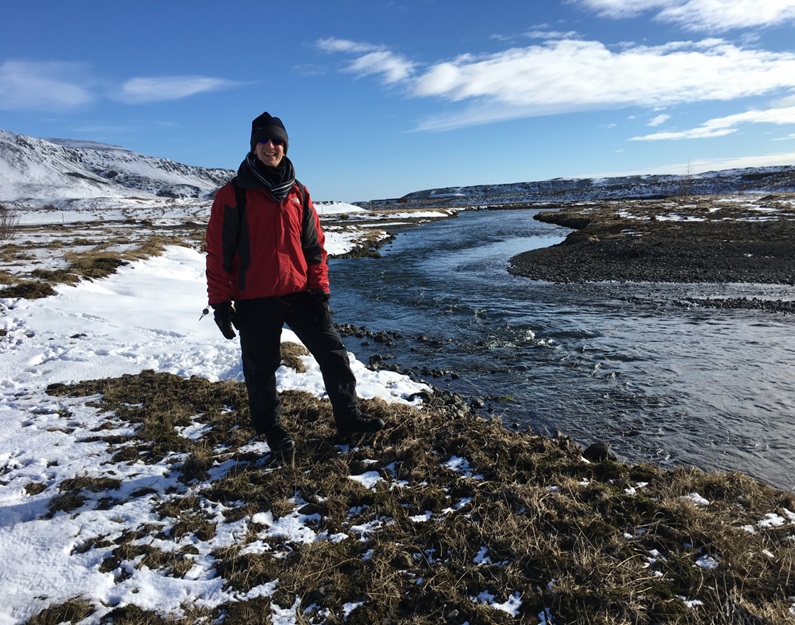
Exploring the river at the bottom of the Reykjadalur hiking trail
There are natural hot springs at the top where you can bathe, but during the winter it didn't seem like anyone else was doing this so we decided to pass. We also had our doubts over the safety of going into a totally natural pool where there wasn't any sense check on the temperature of the pools, even if others were doing it and in the bitter cold of the winter changing before and after without any shelter would have been a challenge. Probably one for the summer. After the hike we drove to Hvolsvöllur for our second nights accommodation at Eg Homestay. An alternative option if you want to look out for the Northern Lights (or even get a wake up call when they appear) is Hotel Ranga.
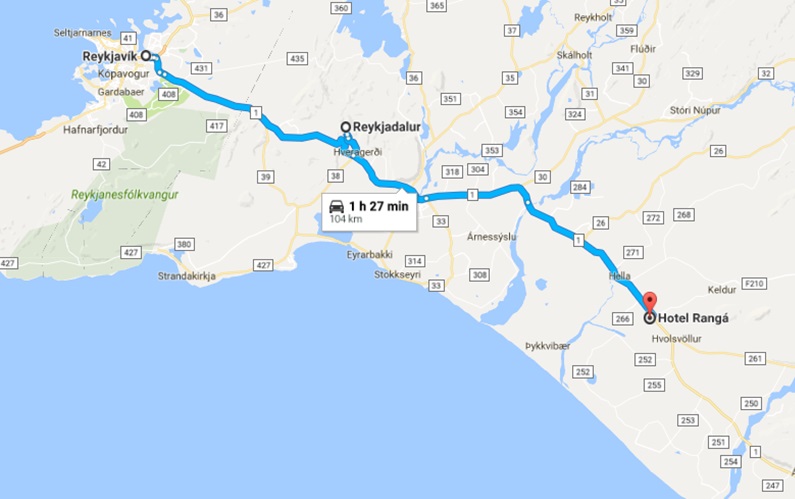
Map of Reykjavik to Hotel Ranga
Day 3 (Monday) - part of Golden Circle - Seljalandsfoss Waterfall, Skogafoss waterfall and the Black Beach
We used day 3 to tick off some of the popular tourist spots beyond the Golden Circle - Seljalandsfoss Waterfall, Skogafoss waterfall and the Black Beach. We had also planned to do a glacier trek at Solheimajokull during the afternoon but unfortunately this was cancelled due to bad weather, as is sometimes the way in Iceland's constantly changing climate.
Seljalandsfoss waterfall is one of the best known waterfalls in Iceland and falls over 65 metres over an old sea cliff. It is possible to walk behind and circle around the waterfall to take it in from all angles. When the sun shines, rainbows appear giving it a magical appearance whilst the thundering sound of the waterfall plays in the background. Our top tip is to bring a raincoat as you will get wet from the water spray. Sturdy walking boots with good grip is also a must, particularly during the winter when the paths to the back of the waterfall can get icy and slippy. The paths behind are sometimes closed during the winter when it gets very slippery and too dangerous. Definitely don't come out in skirt, tights and slippers as we saw one tourist wearing as they walked gingerly along the paths approaching the waterfall!
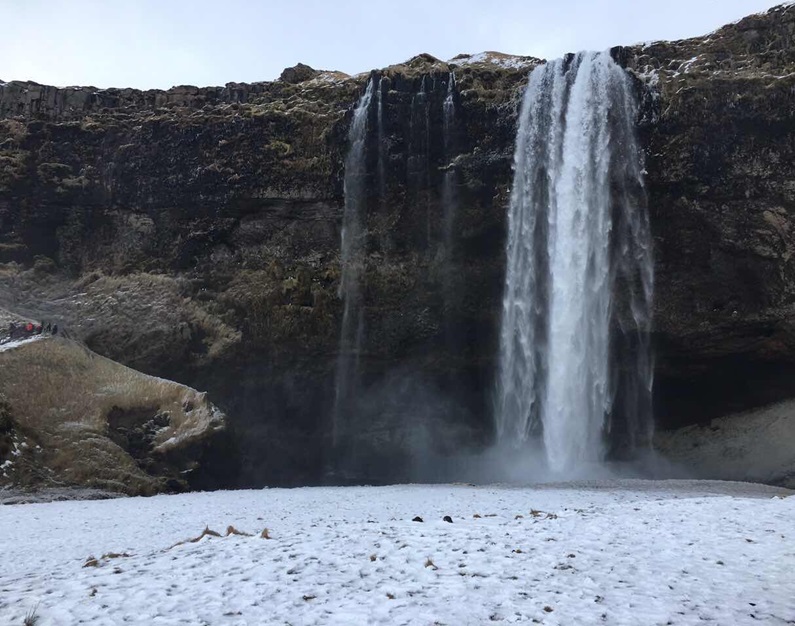
Seljalandsfoss waterfall
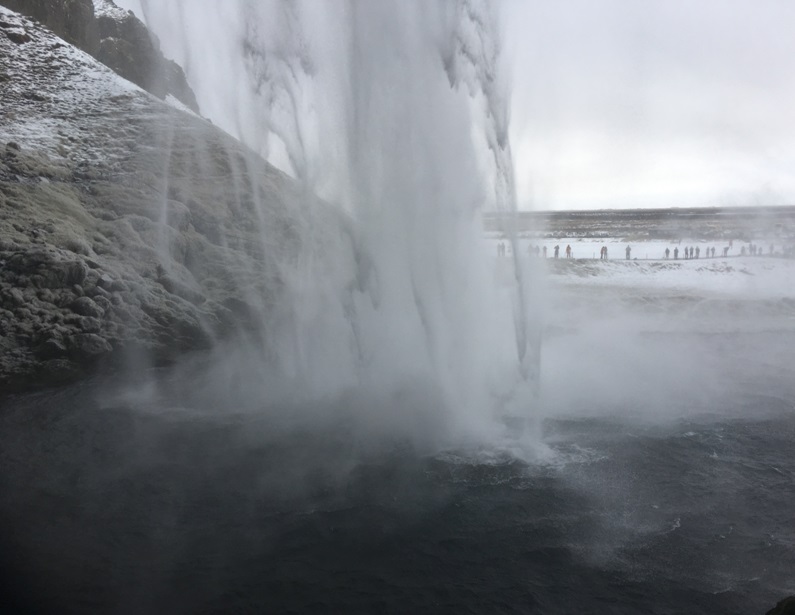
Behind Seljalandsfoss waterfall
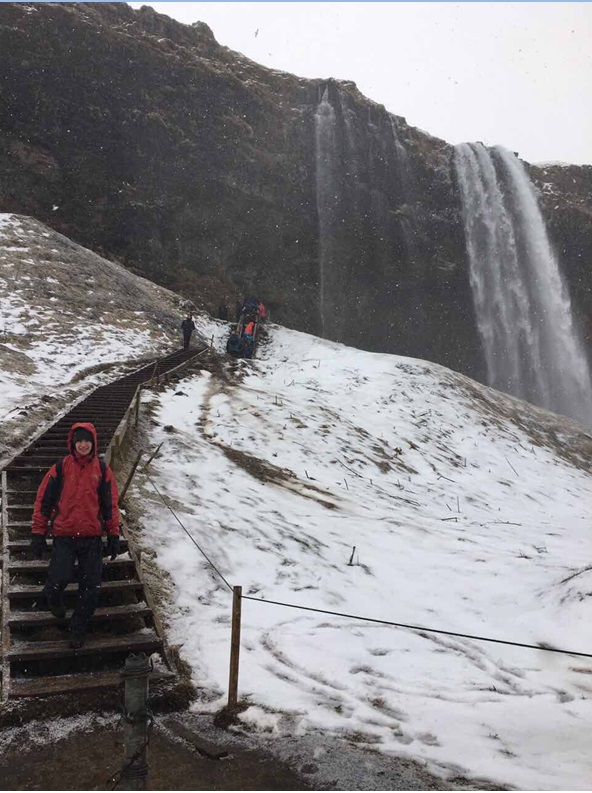
Returning from the slippery path that leads behind Seljalandsfoss waterfall
After you've seen Seljalandsfoss waterfall take the short walk down the path running along the bottom of the cliff face. This leads to other smaller waterfalls, including Gljúfrabúi waterfall, which means "dweller of the gorge". Gljúfrabúi is hidden behind a rock formation which initially just seems like a gentle stream running through the landscape. This rock is called Franskanef cliff or the French nose. If you tread carefully in waterproof shoes you can get to the foot of this waterfall with fewer tourists than around the main Seljalandsfoss waterfall. At 40 metres high with the plunge pool contained in a sort of chamber it's great to feel the power of the water spray up close.
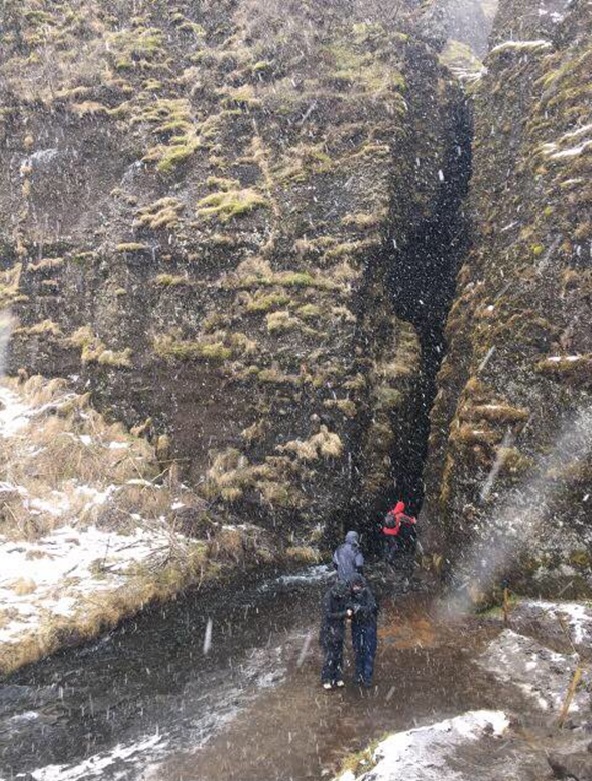
Path to the "dweller of the gorge" waterfall
Skogafoss waterfall is just a further 30km east of Seljalandsfoss waterfall and about 120km from Reykjavik, so you can take an organised day trip to see both and return to Reykjavik the same day if you haven't hired your own car (although we would discourage you to base yourself from Reykjavik permanently as its dull and drab and all the best things to see are outside of the capital). You can spot Seljalandsfoss from the motorway as you approach. It initially looks like a spec in the distance but you'll appreciate it's size and grandeur as you approach. The walk up to Skogafoss feels more volcanic with black sand and rocks and is breathtakingly beautiful as you get up close. When you get up close you can see, hear and feel the immense mesmerising power of the waterfall which is 60 metres high and 25 metres wide. As well as viewing it from the base, you can also walk up a lung-busting set of 527 steps to reach a viewing platform at the top. From the top viewing platform you can look down at the thundering waterfall and see the river flowing upstream. According the legend there is a chest filled with gold and treasures behind Skogafoss waterfall, although you'd be a braver man than me to try and find it!
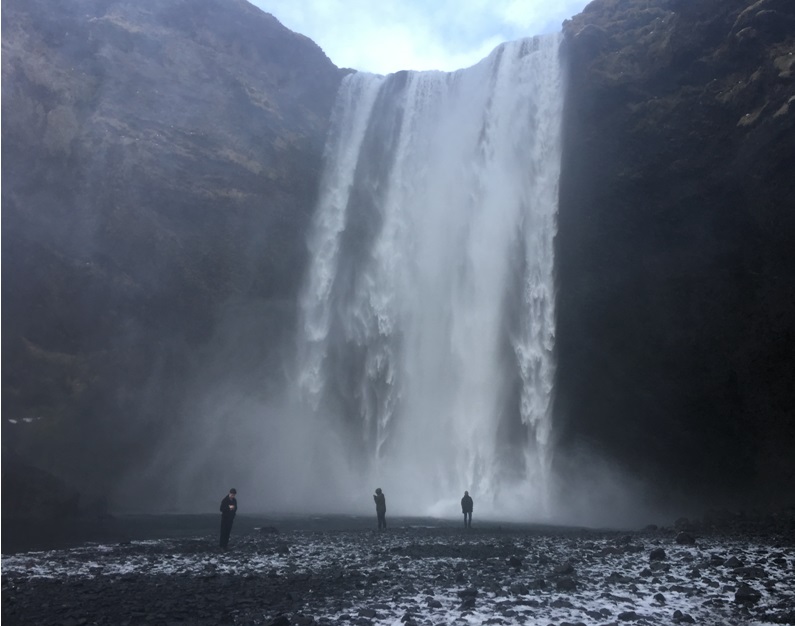
Skogafoss waterfall
We had originally planned to stay in Vik for the night before travelling back west the next day, but as our glacier trek had been cancelled we travelled back to Laugarvatn in the evening to see Þingvellir national park the next day.
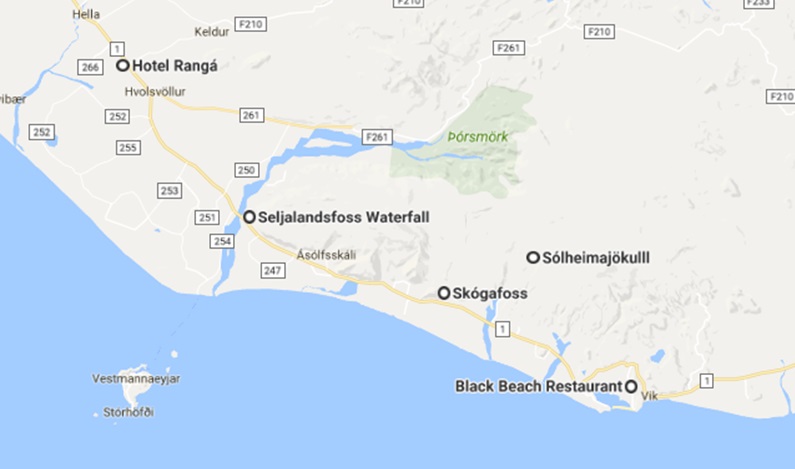
Map of the Seljalandsfoss waterfall, Skogafoss waterfall and black beach
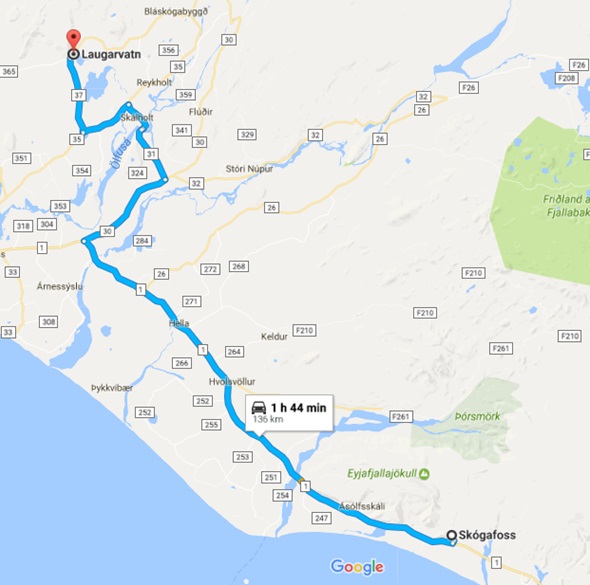
Returning from Skogafoss to Laugarvatn
Day 4 (Tuesday) - sightseeing Þingvellir national park, dog sledding and the Laugarvatn Fontana Icelandic spa
Þingvellir national park is Iceland's most important historic site and a place of incredible natural beauty. This is where the Vikings established the world's first democratic parliament, the Alpingi, in 930 AD. The site has a superb natural setting, in an immense, fissured rift valley caused by the meeting of the North American and Eurasian tectonic plates, with beautiful rivers and waterfalls. You can literally see the tearing apart of the two continental plates first hand, which is fascinating. This is happening at a rate of 1mm to 18mm per year and as a result the land is scarred by dramatic fissures, ponds and rivers. Þingvellir was Iceland's first national park and now a world heritage site. Allow 3-4 hours to see the site in full.
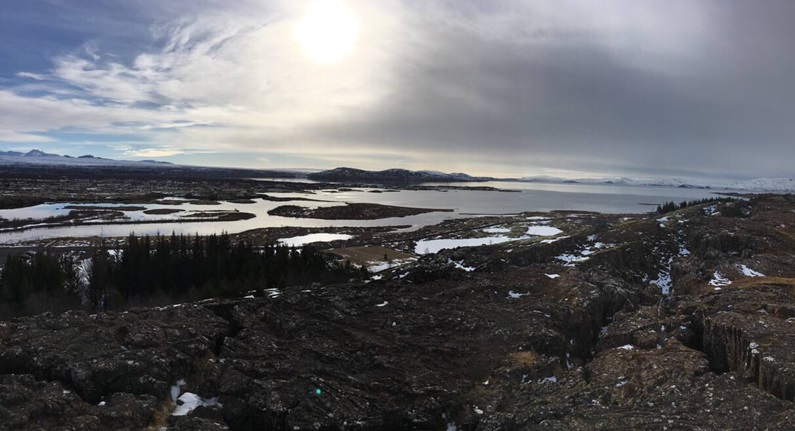
Fissued rift valley caused by the meeting of the North American and Eurasian tectonic plates
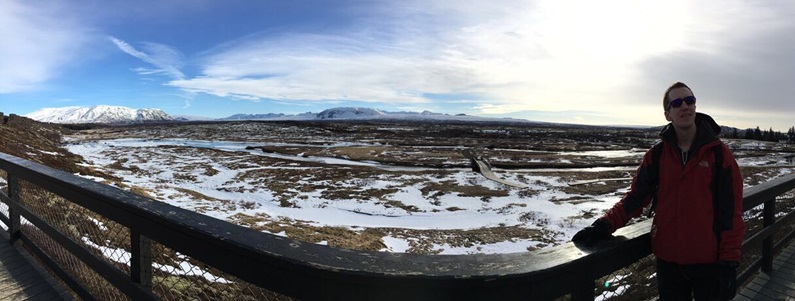
Panoramic view of Þingvellir, Iceland's first national park
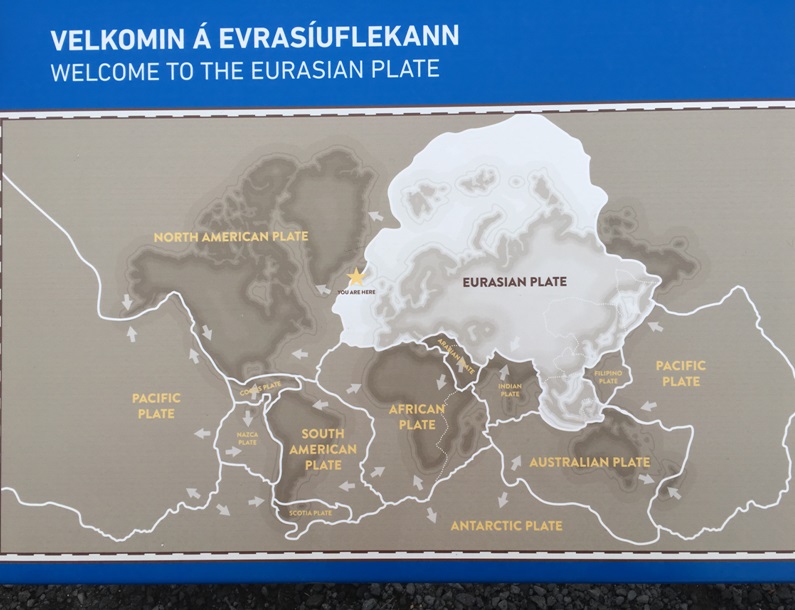
Iceland's tectonic plate activity
We recommend starting by exploring the Oxarafoss waterfall on the northern edge of the Alpingi site, which originates from the Oxara river, tumbling off its edge in a series of pretty cascades. Next, walk the path that runs along the fault between the cliff-top visitors centre and the Alpingi site, along which you will see the Drekkingarhylur pool which was used to drown women found guilty of infanticide, adultery or other serious crimes. There are other small fissures on the eastern edge of the site. During the 17th century 9 men accused or witchcraft were burnt at the stake in Brennugja (the "Burning Chasm"). Pop into the visitors centre when you reach the top of the path to take a look at the interesting, interactive displays which really bring the story of the area to life (this initially just feels like a shop but the interactive displays are hidden away at the back). After the visitor centre explore the various paths down through the small town and past the village on your way back to the car park.
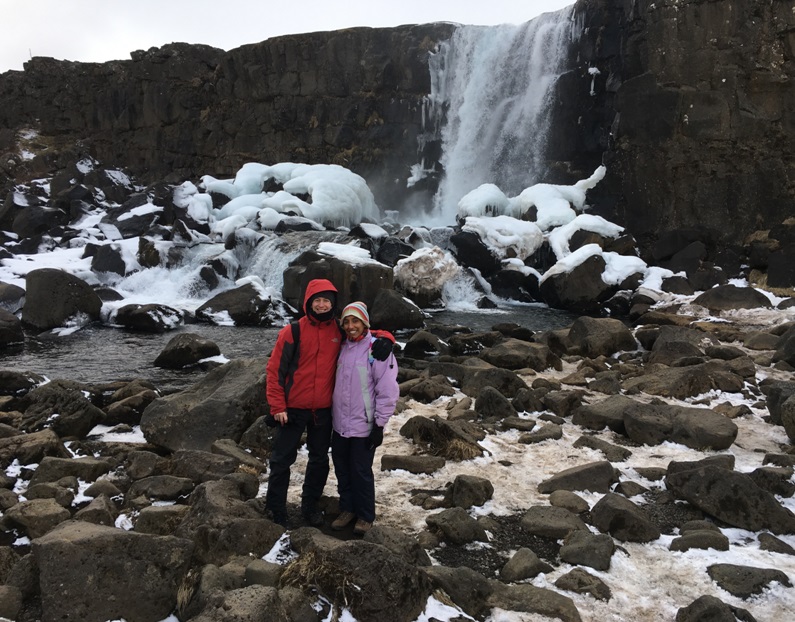
Oxarafoss waterfall on the northern edge of the Alpingi site
In the afternoon we went dog sledding with Dog Sledding Iceland which was the highlight of our holiday. At the time of writing Dog Sledding Iceland are the only company who offer dog tours in Iceland and run them from one of two locations both in the south west and easily accessible from Reykjavik, depending on the amount of snow cover. Dog Sledding Iceland is a family owned business around 60 dogs in total which are clearly well loved and cared for. The sledding part of the experience last for around 40 minutes and there is ample opportunity to take pictures with the dogs and sleds and fuss the dogs for as long as you want at the end. The sledding is actually in a buggy at times of the year when there is insufficient snow cover, as was the case when we visited. Each buggy or sled has a musher (a member of the staff rather than a guest) which steers and commands a team of 8-10 dogs.
There are universal dog sledding commands: "haw" means turn left; "gee" means turn right; "whoa" means stop and "All Right" means get moving. Whilst the dogs respond to the commands it's actually the pitch of the mushers voice that dictates the speed: high pitched commands encourage the dogs to run harder and drive the sled or cart faster, whilst deeper pitched commands yield a slower less enthusiastic response! Our musher was knowledgeable and experienced and talked about how they have to spend time to develop bonds particularly with the lead dogs so that they will follow their instructions when sledding. It was very evidently a two-way relationship with the mushers needing to earn the respect of the dogs for the dogs to then want to work for them when pulling.
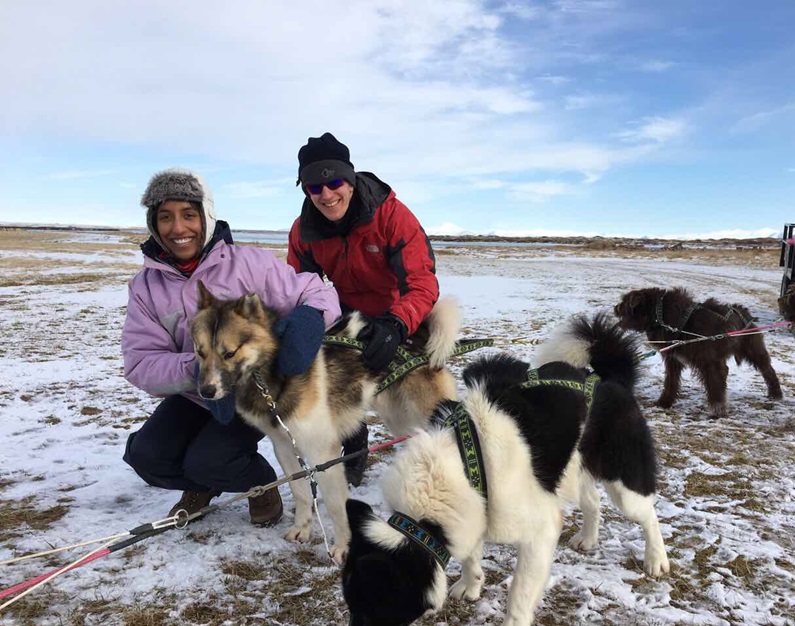
Taking a break mid way through the 10k dog sledding trip
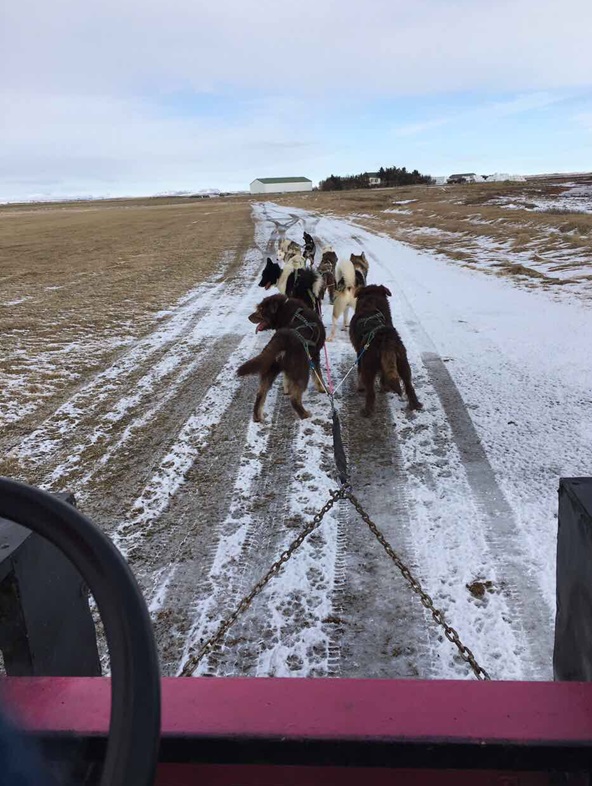
Ready, Steady, Mush!
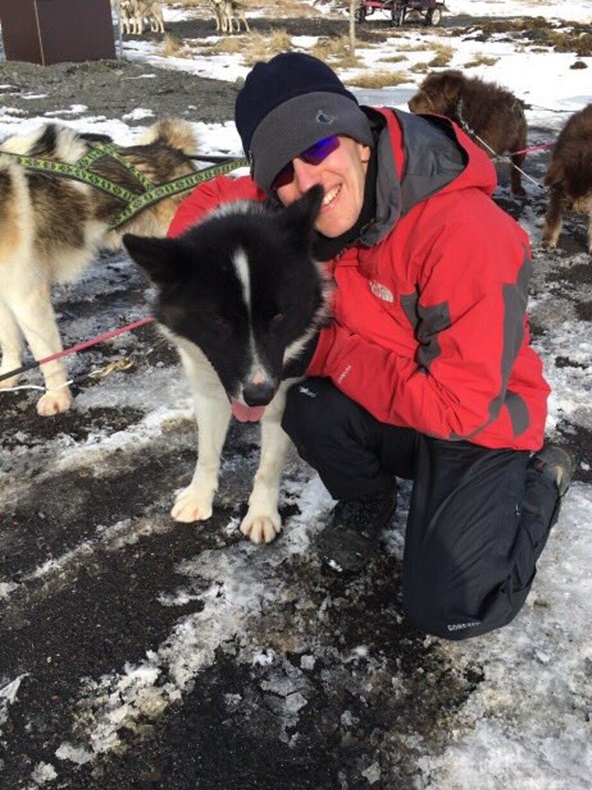
My favourite dog, petit pois
We rounded off the day with a trip to the Laugarvatn Fontana Icelandic spa. As we were staying at nearby Galleri Laugarvatn guest house we managed to get a bit of discount but still the spa was pretty pricey at about £23 equivalent per person. Laugarvatn prides itself as being a wellness centre built on natural hot springs with five different pools at different temperatures, progressively getting hotter, sauna, steam rooms also at different temperatures and the lake when you can dip into to cool off if you're feeling brave. To give an honest view whilst not being quite as bad and commercial as the Blue Lagoon, it isn't worth it unless you have lots of spare cash and time to kill. By far the best spa in Iceland is the Secret Lagoon. Being able to dip into the lake is a cool feature and the different pools getting progressively hotter are done well, but the steam rooms smell displeasingly sulphurous (natural but not pleasant), and it felt a bit overpriced.
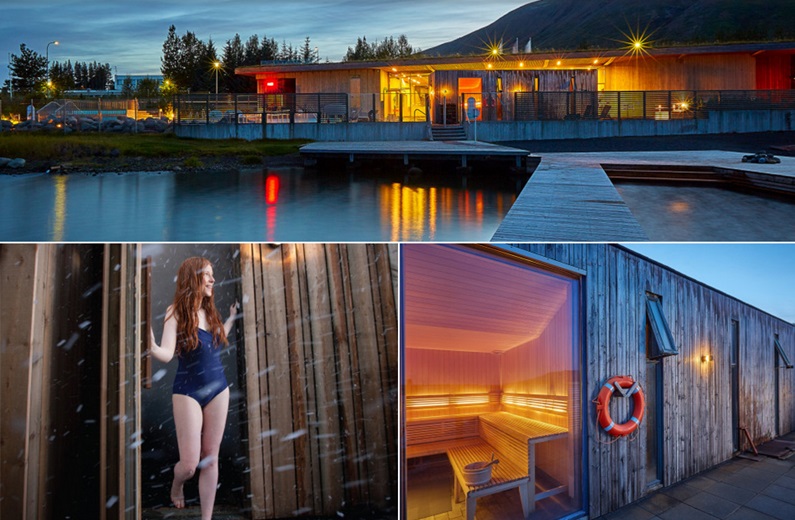
Laugarvatn Fontana Icelandic spa
Day 5 (Wednesday) - Golden Circle route to see the Geyser and Gullfoss waterfall, ending day at Secret lagoon
On Wednesday we ticked off the rest of the Golden Circle sites - the Strokkur geyser and Gullfoss waterfall. We had also intended to visit the Burfell hydroelectric power station but only realised upon arrival that it's only open during the summer, so spent an afternoon in the Secret Lagoon instead. The Strokkur geyser is located in a geothermal area beside the Hvita River. It is one of Iceland's most famous geysers, erupting once every 6-10 minutes usually to 15-20 metres and sometimes up to 40 metres high. There is no way of knowing exactly when this will happen and the suspense is part of the beauty of this geological phenomenon. These is a tourist path that meanders around other hot pools and steaming hot "plates" of water whilst you can explore between geyser eruptions. Unfortunately, the main geyser (actually called Geyser, which is how all others took their name) no longer erupts. There is a clothes shop nearby and quad bike tours operate from just a couple of minutes away.
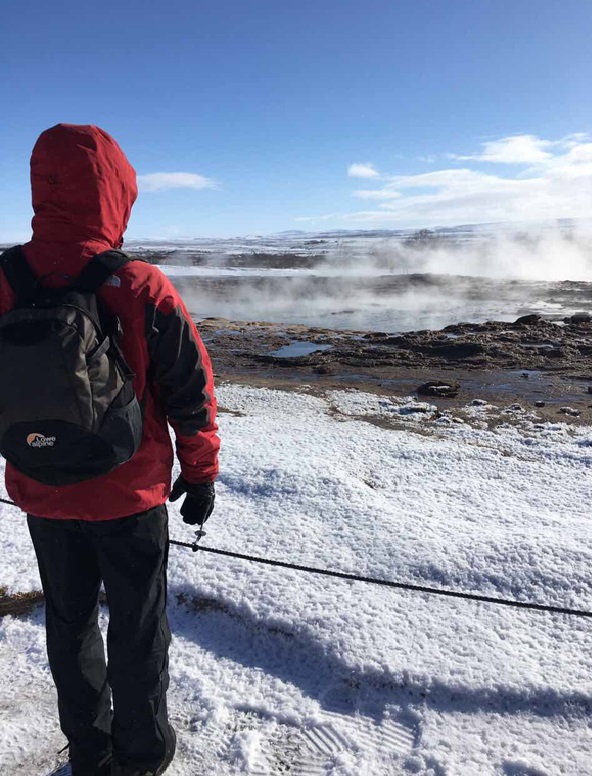
Waiting patiently in anticipation
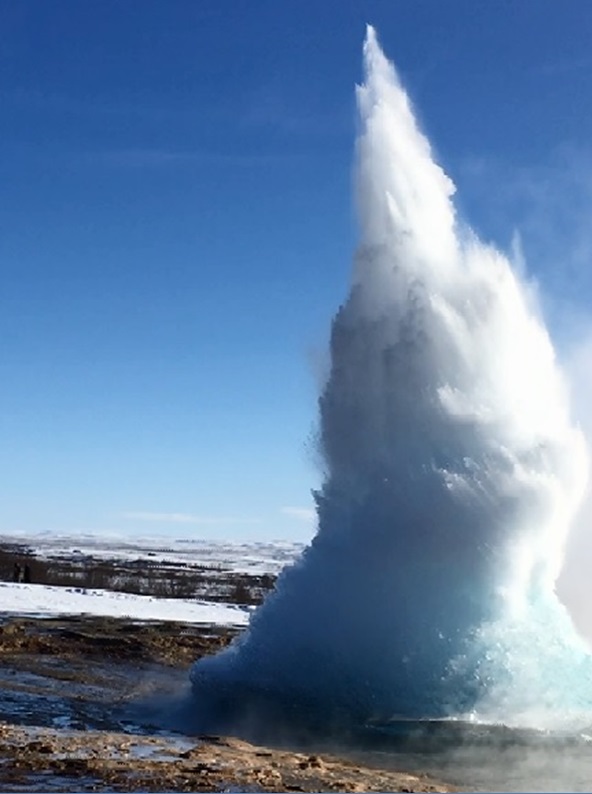
The Strokkur geyser erupts once every 6-10 minutes
Gullfoss waterfall is just a 10 minute drive east of Strokkur geyser, located on the Hvita (white) river which is fed by Iceland's second largest glacier, the Langjokull. It is Iceland's most famous (and from what we saw most photographed) waterfall dropping 32 metres and kicking up tiered walls of spray in a spectacular display of the forces of untouched nature before thundering away down a narrow ravine. Also known as the golden falls with a spectacular double cascade, on sunny days a shimmering rainbow can be seen over the falls and in winter it's magical when the falls glitter with ice. The information boards are worth a read to learn how Gullfoss was nearly used to create a hydroelectricity plant but the tenacity of the owner's daughter determined to preserve it's natural condition prevented this from happening.
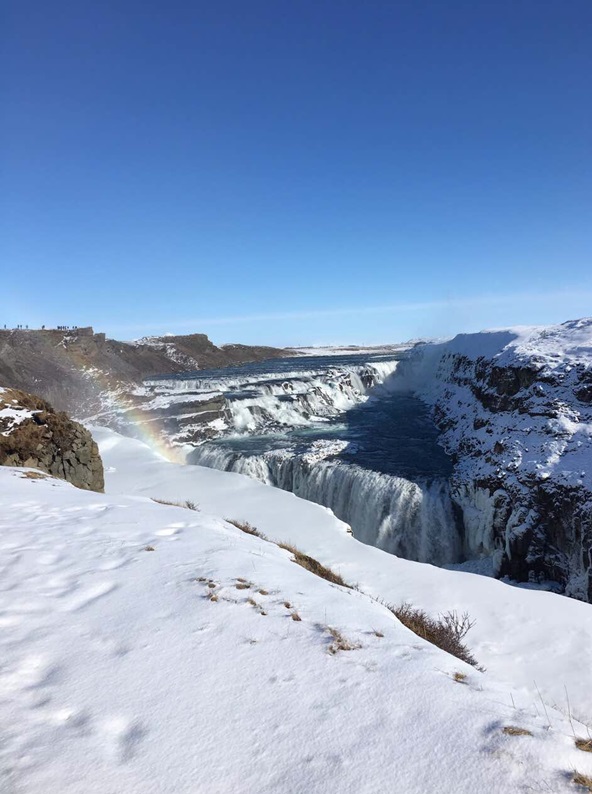
Approaching the Gullfoss waterfall
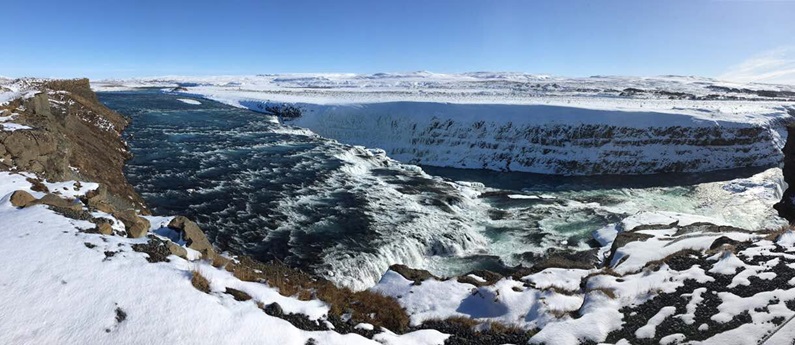
Gullfoss waterfall - upstream
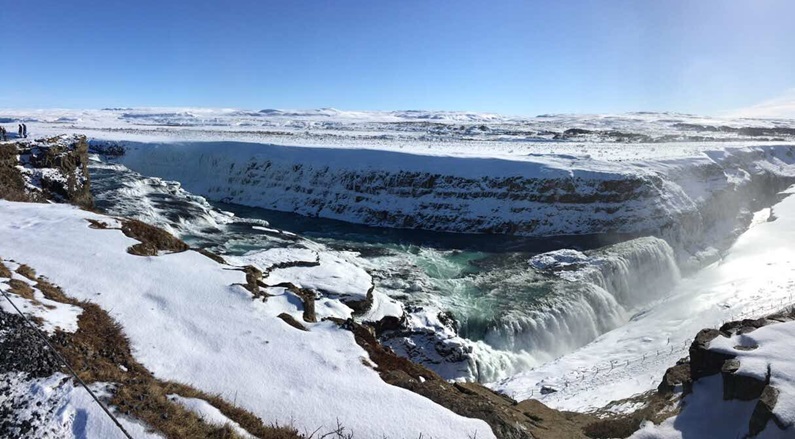
The beautiful Gullfoss waterfall
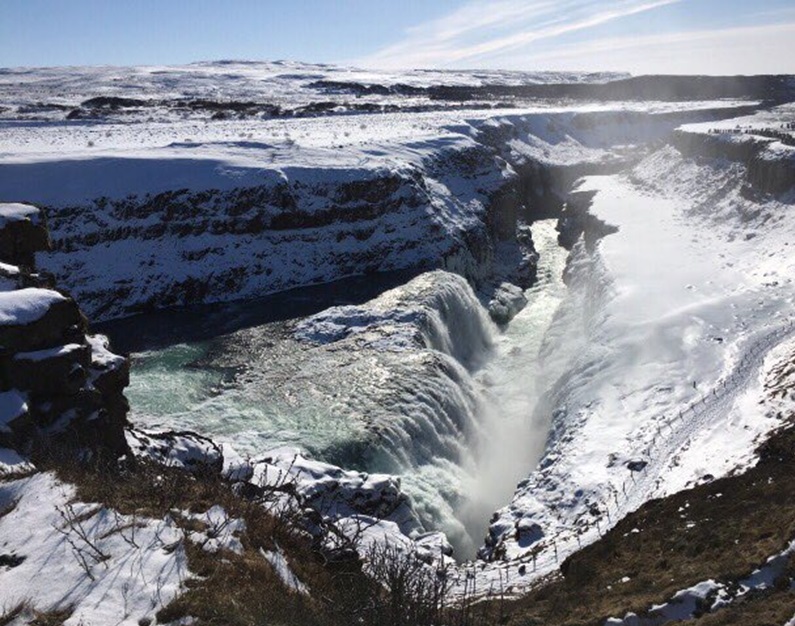
Gullfoss waterfall gorge
We wrapped up the day with a visit to the Secret Lagoon. This is by far the best geothermal springs bathing area you will find in the south west of Iceland and is highly recommended. If you only have the time or money for one lagoon/spa visit, make it the Secret Lagoon. It comprises of a single pool but feels completely natural and far less commerciality as places such as the Blue Lagoon with the hot geothermal water trickling down the rocks on one side of the pool. The highlight is the small area of geothermal activity around the back of the pool accessible by a raised wooden path which meanders through bubbling mud pools, "plates" of steaming hot water and even its own small geyser (right at the end of the path) which throws up water in a fit of rage every 10 minutes or so.
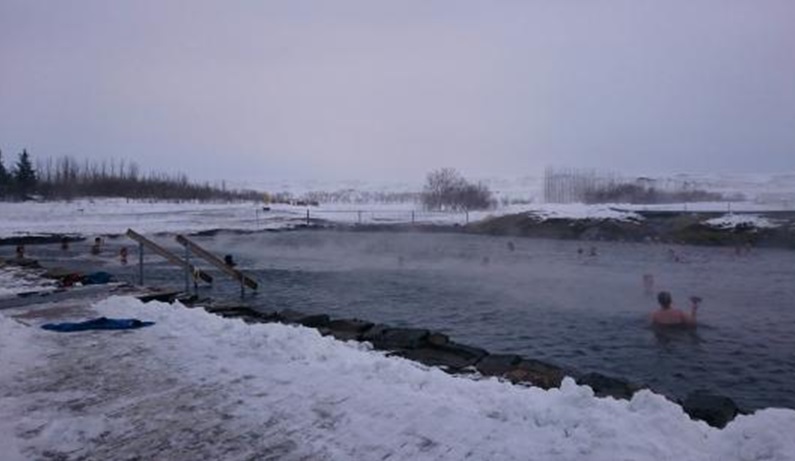
The Secret Lagoon - best geothermal springs in south west Iceland
For the evening we decided to re-arrange our original accommodation in Reykjavik last minute, opting for the countryside location of Fludir instead to give us the best chance of seeing the Northern Lights. We had arranged the trip with www.booking.com who were extremely helpful in re-arranging for us and even helped us to avoid a cancellation fee which should have been payable given the short notice. We have used http://www.booking.com for some time now and strongly recommend it for planning trips. There is a booking.com app that you can use easily on your phone whilst away and our experience of their customer service whilst abroad was second to none.
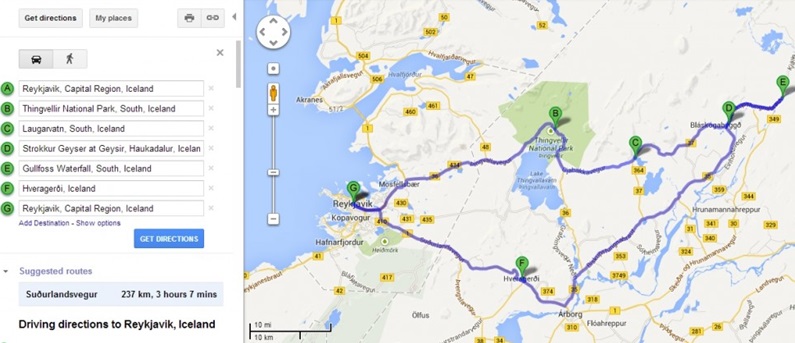
Some key spots on the Golden Circle route
Day 6 (Thursday) - exploring Reykjavik and taking in a symphony orchestra show at the Harpa opera house
We spent Thursday exploring the capital Reykjavik. Reykjavik should be viewed as a hub from which you can access and explore the stunning natural beauty outside of the capital. The city itself is ugly with bland buildings and graffiti everywhere which is a massive eyesore. Construction dominates the skyline and many of the streets are overshadowed by fast food or rip off eateries with not much else to do. The only two places worthy of a visit are the National Museum and Harpa concert all. The National Museum offers a detailed look into the history of the island and its people and takes 3-5 hours to explore in full. You won't miss the Harpa concert hall because it's the only attractive building on the skyline, worth visiting to see its unusual lighting effect up close and delivering very well-rated shows. We were lucky enough to catch the national symphonic orchestra who were visiting and were excellent. Accommodation in Reykjavik is expensive, so if you've self-arranged your trip and have a car we'd recommend staying somewhere a little outside of the city. We booked at Fitjar Guesthouse around 15 minutes north of the centre of the city which offered comfortable accommodation with shared kitchen and bathroom and horses and farm animals to say hello to in the morning.
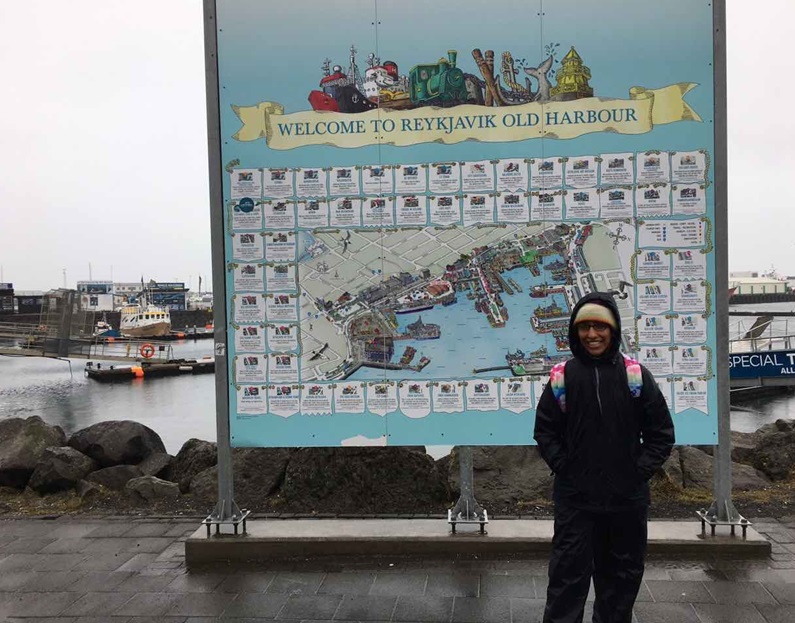
Reykjavic Old Harbour
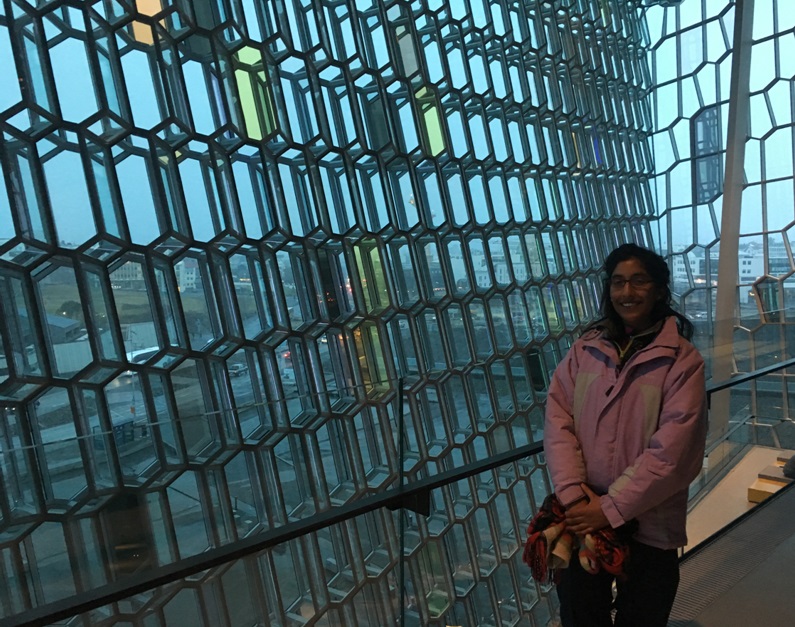
Inside the Harpa opera house
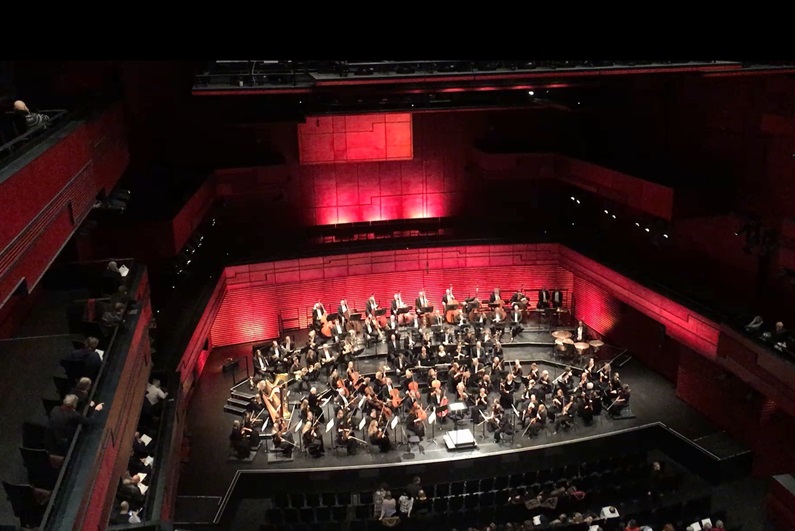
National symphonic orchestra at the Harpa opera house
Day 7 (Friday) - trip to Reykjanes to see the bridge between two continents, coastal cliffs and lighthouse
We started the day by visiting the Rekyjanes bridge that spans a major fissure between the Eurasian and North American tectonic plates, providing clear evidence of the diverging plate margin. These plates are continuously drifting apart under immense geological forces with fissures caused by the stresses from the tension that builds up as the plates move away from each other. The North American plate is drifting to the west away from the Eurasian plate, widening the Atlantic Ocean in the process. In the east, the Pacific and Philippine plates flow under the Eurasian plate and form an arc of volcanic islands. In the south, the Indian and Australian plates are drifting to the north. The collision of these plates forms the highest mountain range on earth, the Himalayas.
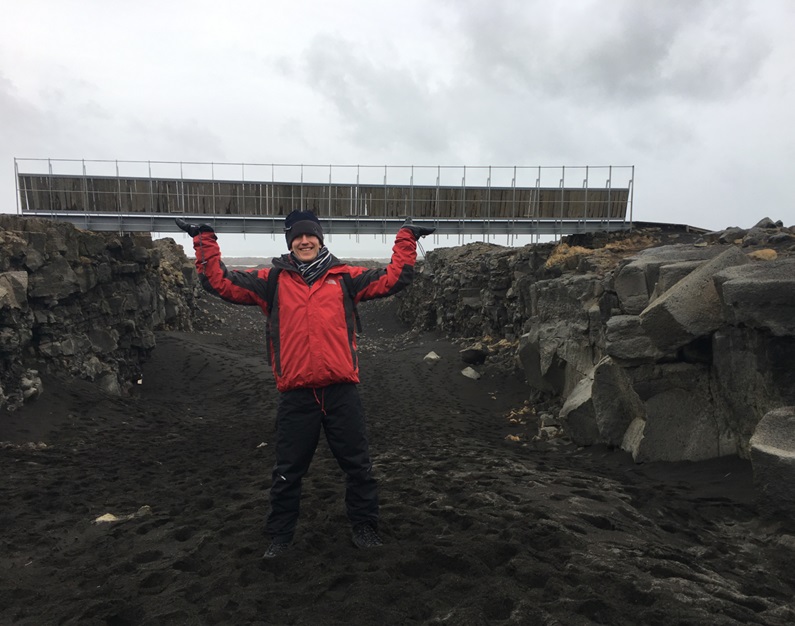
Reykjanes bridge between two continents

Major fissure between the Eurasian and North American tectonic plates
Next, we went to see the Valahnukur coastal cliffs and Reykjanesviti lighthouse. Valahnúkur is composed of tuff layers, pillow lava and breccia. The mountain was formed in a single eruption and shows evidence of the different phases of the eruption. The tuff forms in explosive eruption, while the pillow lava forms when the lava erupts under water. There is also a sculpture and information about the now extinct Great Auk bird. Nearby is Reykjanesviti lighthouse, Iceland's oldest lighthouse. The lighthouse isn't worth seeing itself but the short walk there from the cliffs is worthwhile to take in Iceland's rugged, cratered, Martian-like volcanic landscape once more.

Valahnukur coastal cliffs

Cratered, Martian-like landscape
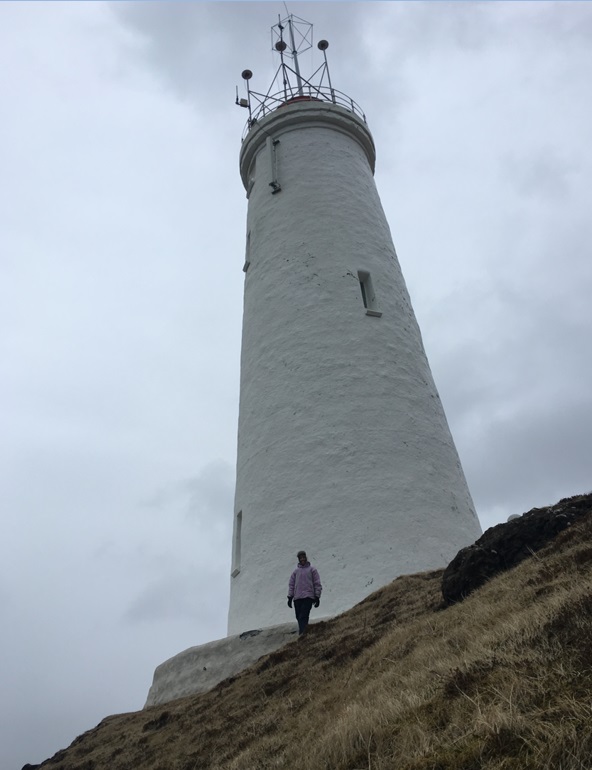
Reykjanesviti lighthouse
We spent the final evening in the Blue Lagoon. In three words the Blue Lagoon is pretentious, commercialised and over crowded. It is a large attraction with a vast and expanding area of lagoon with pool bar, sauna, steam room, mini waterfall, silica bar where you can spread silica over your face to cleanse your pores, cafe, restaurant and indoor viewing area. The silica face mask available on a "help yourself" basis from a silica station is the highlight (don't take silica you may find on the floor and rocks elsewhere in the lagoon as it has not been treated and smells like sulphur which does not feel or look very good for your skin). Expect to come across loud and boisterous school trips and plenty of tourists spending hours trying to get the perfect selfie. For the evening we stayed at Lagafell Guesthouse on the south coastal town of Grindavik.
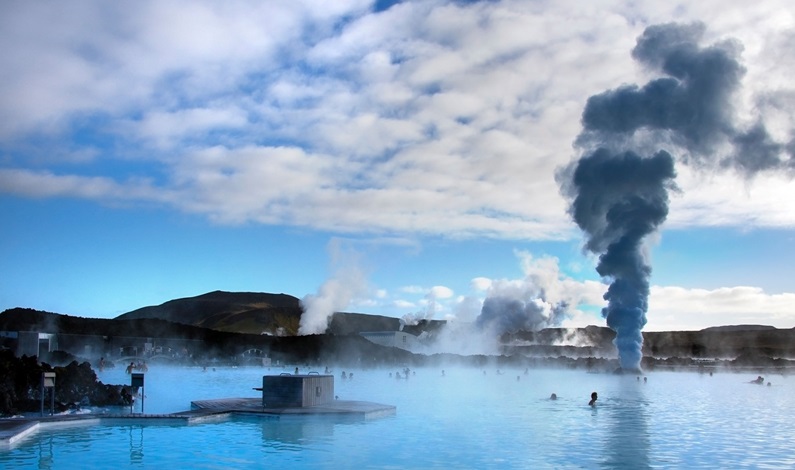
The pretentious tourist trap that is the Blue Lagoon
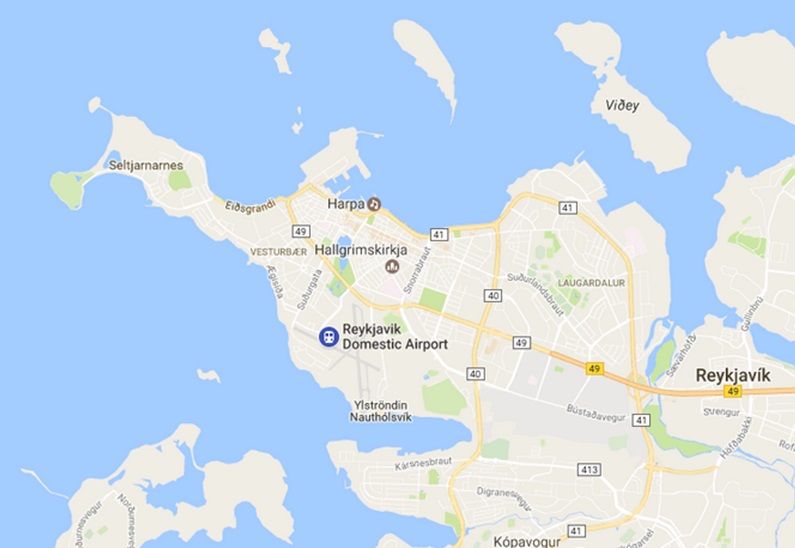
Reykjavik Town
Day 8 (Saturday) - Coastal drive to the Hopsnes skipwrecks, Graenavatan explosion crater and Kleifarvatn lake
We spent the morning exploring the Hopsnes coastal path at Grindavik. This is a small peninsula, created 2,350 years ago by lava flow from the nearby Sundahnukar volcano. It is possible to find some of the oldest remains of the salt fish production in Iceland around the bay, wrecks of ships that have stranded in the bay area of Grindavik and a lighthouse built in 1928. A road of 3-4 miles runs around the peninsula which is not tarmac but easily accessible in a normal estate car in reasonable weather. It's all flat and possible to walk around if you prefer. If you head east after the peninsula you'll also drive past Festarfjall, an eroded sub glacial volcano with one side exposed to the cliffs.
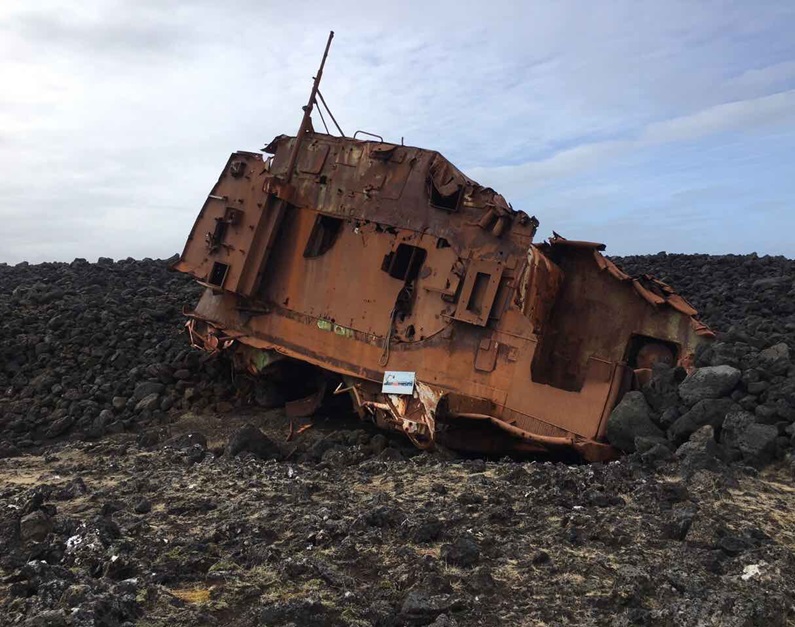
Some of the oldest remains of fish production stranded in the bay area of Grindavik
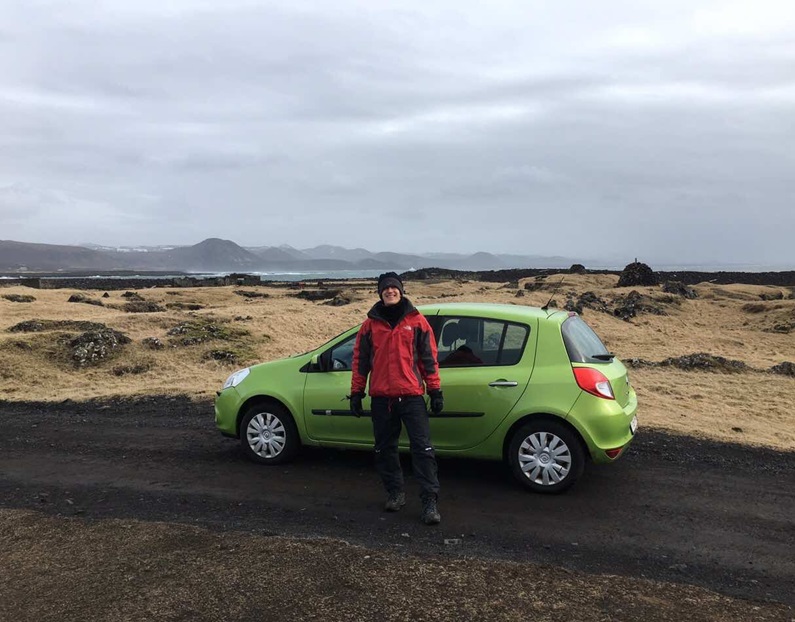
The coastal path around Grindavik is easily accessible in a normal estate car in reasonable weather
Our next stop was Graenavatn, around 30 minutes east. Graenavatn plays host to two explosion craters, probably over 6,000 years old. Both of the craters are lake filled today. It's possible to walk around the craters, there seems to be a path but from our experience it didn't lead anywhere. A little drive further and you get to Sveifluhals, a hyaloclastite ridge of 395m, popular for hiking with great geothermal activity on its southern slopes. We visited but the eggy sulphurous odour was far worse than anything else we'd experienced in Iceland. The stench was so revolting that we had to run back to the car after going less than 20 metres onto the path!
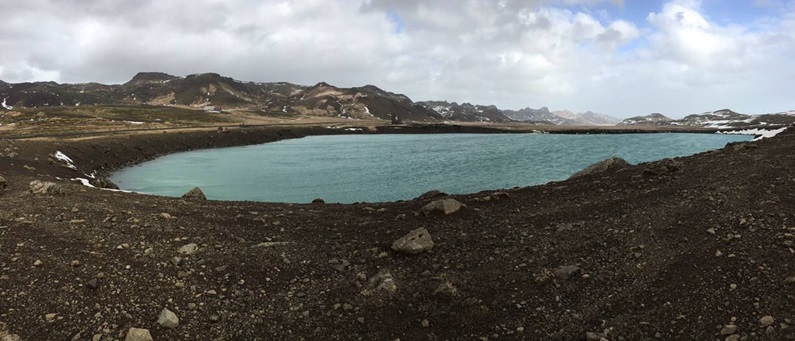
One of Graenavatn's explosion craters that is lake filled today
Our final stop off way Kleifarvatn, the largest lake of the Reykjanes Peninsula and one of the deepest lakes in the country. Its catchment area is small and it has a very limited discharge to the surface. Since the year 2000 it has diminished in size because of two major earthquakes, which probably opened up fissures at its bottom. We then headed back to Keflavik Airport, returned our car to FairCar and waved our goodbye to this beautiful country.
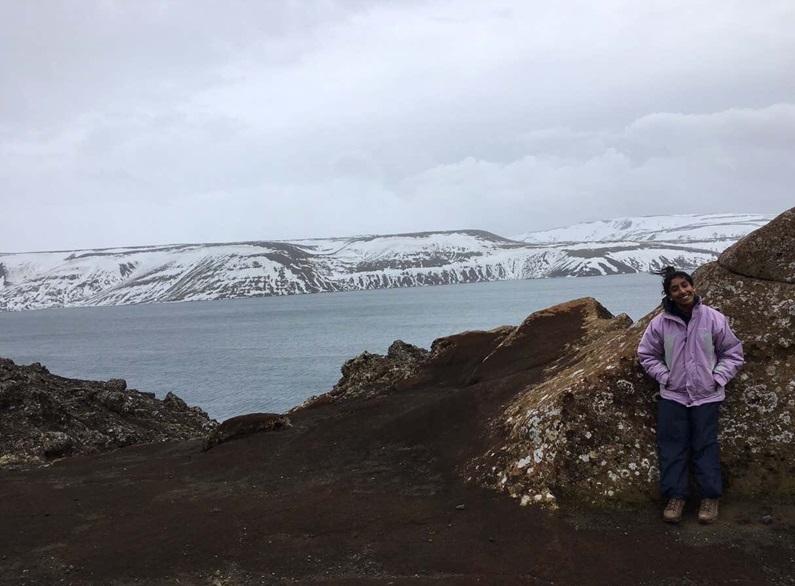
Kleifarvatn, the largest lake of the Reykjanes Peninsula

Panoramic view from a rock overlooking the Reykjanes Peninsula
Eating and Drinking in Iceland
Eating and drinking in Iceland can be very expensive. If money was no object, you could easily end up spending upwards of £100 a day on hotel prepared breakfasts and fancy meals out. But this needn't be the case and it's very possible to travel Iceland on a relatively modest budget by cooking yourself. Use the Bonus supermarkets rather than alternatives such as Netto. Bonus seem to import a lot of goods from other countries (for example cereal packets with in English). Prices at Bonus supermarkets are about the same as the UK - maybe a fraction more - whereas other places are around 1.5-2x the price.
Some guests houses offer self service breakfasts included with very reasonably room rates and if you ask nicely they will sometimes also allow you to use bread, cheese and pepperoni to make up sandwiches for lunch time. Evening meals roughly double the price of the UK at £20-50 for a main course. Fish and chips for example was typically £20-25 even at the keener priced places we saw. If you have any sort of budget limitations when you travel eat out once or not at all and save your money for the activities. We were originally going to have one evening meal out to experience traditional Icelandic cuisine in the capital, but didn't bother in the end.
Even in the central square of the historic 'old town' part of Reykjavik which some guide books describe as lovely and quaint, the food options were literally an American diner, English pub, sushi bar and pizzeria with a Cafe Paris due to open within the next few months. Definitely international but nothing you can't get back home and at 2-3x the usual price!
How to get around Iceland
Hiring a car or 4x4 is the best way to experience Iceland, allowing you to get around in your own time and see what you want to see, rather than being restricted by coach tour timeframe. Car hire allows you to see many of the less touristy hidden gems that are sometimes a little off the beaten track which can by experienced in the company of a few (rather than couple of hundred) fellow travellers in the off season. The main decision to make is whether to go for a compact/estate car (around £200 for a week in off season) or a 4x4 (more like £600-800 per week depending on make, model, spec and when you travel). We opted for a compact car to keep costs down and don't really feel like it restricted our holiday.
Iceland has 2 types of road: (1) "main" paved or occasionally compact gravel roads which subject to weather, snow and ice conditions can be suitable for all cars; and (2) "F-roads" which are basically very rugged off roads trails. It's important to understand that F-roads are too challenging for normal 4x4s, especially in the winter. You'll see monster trucks driven by the locals when you visit which are huge trucks with very high suspension and super wide tyres, which is the type of thing you need to tackle the F-roads. Choose a 4x4 if you're less confident driving in snowy and icy conditions or if you want a bit more capability to travel on the "main" roads when weather conditions are more challenging, but don't expect to be able to take off anywhere in a Toyota Land Cruiser or Nissan X-Trail, especially in the winter.
We used and would recommend Faircar car hire, who were the most competitively priced for compact and estate car hire at the time we travelled. Fair Car's base is 5 minutes drive from Keflavik international airport (to help keep their costs down) but they put on a minibus transfer to and from the airport which was ready and waiting when we landed and prompt ahead of our return home. Use the price comparison website Travel Supermarket to find the best deal when you travel. If you prefer the 4x4 option a few rental companies at the time of writing are Go Iceland, Iceland 4x4 Car Rental and Thrifty Car Rental.
How to Travel Iceland on a Budget
Iceland can be very expensive and you could quite easily blow £3,000+ per person for a week with flights, luxury hotels, meals out and tours. However, this doesn't have to be the case and it's very possible to experience everything this fascinating island has to offer on a relatively sensible budget. We have set out our suggestions for travelling Iceland on a budget below, based on a load of research we did before we visited and our own experience of travelling to the south-western area of the island in mid-March.
When you Travel
The main factor that will affect the cost of your holiday, particularly for flights and hotels, is when you travel. Iceland has a concentrated tourist season which peaks from around mid-June to the end of August. During these times, airfares, accommodation and car rental will be materially more expensive and what's more you'll have to share all of the sights and sounds Iceland has to offer with even larger numbers of fellow tourists. Admittedly you might not want to visit in the depths of winter (December to mid February) when the freezing temperatures might be too much for even hardy travellers, but the "shoulder" seasons of October to November and March to May offer affordable breaks with much more bearable conditions. The snow-covered landscape looks all the more beautiful at this time of year; in fact, many Icelanders think the summer tourists don't know what they're missing.
Accommodation
We self-arranged our trip to Iceland, which worked really well. As we travelled off-season in March, none of the guest houses were fully booked; in fact, if we'd have wanted to we could have booked each evenings accommodation on the same day. We have used http://www.booking.com for some time now and strongly recommend it for planning trips. There is a booking.com app that you can use easily on your phone whilst away and our experience of their customer service whilst abroad was second to none. For example, one day we wanted to switch our accommodation around fairly last minute due to cancellation of a glacier trek due to bad weather. Despite being inside of the "non-refund" cancellation period, Booking.com contacted the hotel who kindly agreed to cancel our booking without charge and suggested alternative guest houses for us. Filter hotels by lowest price then look for ones which are well rated (8/10 and over) for the best deals.
Eating and Drinking
Eating and drinking in Iceland can be very expensive and is the next area you'll need to consider to avoid blowing the budget. If money was limitless, you could easily rack up a daily bill of £100 a day on hotel breakfasts and fancy meals out. However, it's also very feasible to spend roughly the same as you would normally in the UK by cooking yourself. Seek out hotels or B&Bs with self catering facilities so you can make your own breakfasts and evening meals - some guest houses even offer self service breakfasts included with very reasonable room rates. Prepare sandwiches in the morning before you head out for the day's activities - if you ask nicely some B&Bs with self-service breakfast offerings will sometimes also allow you to use bread, cheese and pepperoni to make sandwiches for lunch time too.
Some supermarkets - even those you'd think of being budget in the UK such as Netto - can be fairly pricey. The best one to use is the Bonus supermarkets; you'll find one in most major towns. Bonus seem to import a lot of goods from other countries (for example cereal packets with in English). Prices at Bonus supermarkets are about the same as the UK - maybe a fraction more.
Swimming Pools and Spas
Go to local swimming pools instead of the sometimes more commercialised lagoons. In Iceland swimming pools almost always have a jacuzzi and sauna which is an important part of the social scene. You're more likely to meet the locals and can peacefully enjoy the experience without a barrage of tourists taking non stop selfies.
Activities
Unfortunately there is no getting away from the fact that activities such as dog sledding, horse riding, glacier trekking and quad biking are expensive in Iceland. For us these were an important part of our trip so we saved on food and accommodation to allow us to do all the activities we wanted to, except where weather conditions had other ideas. As a rough guide you're looking at £100+ sometimes upwards of £150 for 1 hour of each of these activities, but in our experience the holiday would not have been the same without the dog sledding and horse riding in particular, so we still consider it money well spent.
Holivity is sponsored by Jackson’s Online Garden Centre – your one stop shop for buying plants online. An active holiday does not have to be overseas in a different country. Taking a week or two of downtime in your own garden, planting up a new border, caring for your plant beds or working through gardening jobs can be equally as enjoyable, active and good for the body and mind.
